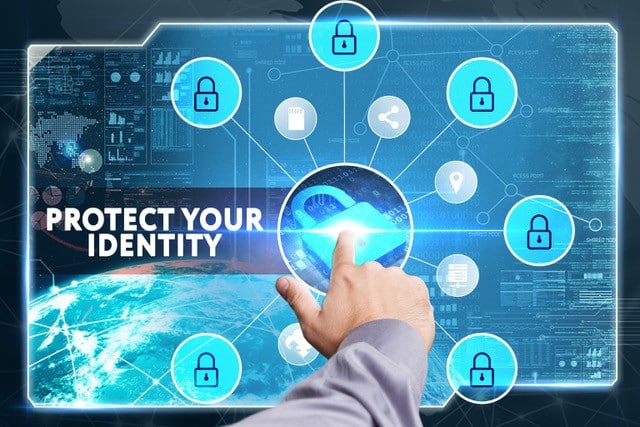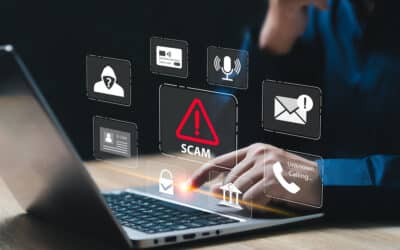Identity theft can happen to anyone and occurs when someone uses another person’s identifying information, typically for a financial gain. There are several ways identity theft can happen:
- Mail Fraud
- Data Breaches
- Digital Service (Apps) Compromise
- Phishing Emails & Texts
To help keep you informed and safe, below are some quick identity theft prevent tips on how to spot these scams, ways to protect yourself or a loved one from identity theft and what to do if your identity or the identity of a loved one has been stolen.
Mail Fraud
While we live in a digital world, mail fraud is still a larger problem than most realize. Fraudsters know there is sensitive information in the mail, such as bills, account statements, tax documents and credit/debit cards, which is why they are eager to get their hands on it. To protect from identity theft, learn the red flags of fraud and how to report it so you can stop identity theft from happening.
Data Breaches
A data breach is when sensitive, protected or confidential information has been exposed, stolen or transmitted without your permission. Fraudsters typically use that information to impersonate you and commit financial fraud. You can take several steps to prevent identity theft from data breaches to keep your finances, credit score and identity safe from criminals—like following cybersecurity best practices.
But if you suspect your information has been stolen in a data breach, you should monitor your credit and accounts and set up fraud alerts as soon as possible.
Monitor Your Credit Report & Account
After a data breach, it’s essential to be vigilant and pay attention to your account activity. Check your statements and watch for any suspicious transactions. You can also sign up for a free annual credit report to check your credit from each of the three major credit bureaus to identify any unauthorized activity.
Set Up Credit Fraud Alerts
If you’ve been part of a data breach, it’s not a bad idea to put a flag on your social security number through your credit bureaus. This will alert you anytime someone attempts to use your information to open a credit account. If you do put a flag on your social security number, make sure you have a valid, up-to-date phone number listed so any business or financial institution is able to contact you to confirm activity is non-suspicious.
Depending on the situation, you may even want to obtain a credit freeze to help mitigate some of the risks of identity theft. Freezing your credit prevents creditors from accessing your credit reports. If you freeze your credit, you will need to provide your name, address, birth date and social security number. To verify your identity, there will be a series of questions to answer and from there you’ll receive a PIN that you can use to unfreeze and refreeze your credit report as needed. Any time your credit is requested, you will have to go through the process of unfreezing your credit to allow for the credit report to be pulled.
Digital Service (Apps) Compromise
With the pandemic came the rise in the demand for more digital experiences. Digital services, or apps, allow consumers to conveniently perform tasks online, like online shopping, opening an account with a financial institution, paying bills, etc. In many instances, those digital experiences require you to input your personal information, including a credit or debit card number and contact details.
Set Up Unique Login Credentials
To help protect that information from cybercriminals, ensure any app or digital service you’re using requires you to have a unique username and password to login. Make sure your password is unique for each app and is different from the one you use to log in to your financial institution’s online banking.
Passwords should include upper and lowercase letters, numbers and symbols to make it even more difficult for criminals to hack into your account. If two-factor authentication is offered as a security feature within the app, it’s highly recommended that you enable it to help further protect your personal information online.
Phishing Emails & Texts
Phishing is the fraudulent attempt to gather sensitive information—such as usernames, passwords and/or financial account details—that’s typically done via email, text or phone call. This is a popular way for scammers to get you to share key information with them so they can use it to commit identity theft and try to financially gain from you. Oftentimes in email and text messages, fraudsters will try to get you to click on a link and sign into a fake website, share your personal or account information or open an attachment that contains malware.
The fraudster may use threatening language and may demand that you respond immediately to their requests. Their offers might also contain information that doesn’t make sense grammatically or includes a lot of typos. A general rule of thumb to follow is if an offer seems too good to be true, it probably is.
Research Suspicious Messages
If you’ve received an email or text message, you can go online and find a phone number for the company from where the text or email was received and call them to confirm the information that was sent wasn’t fraudulent. Do not click on any links in the text or email until you’ve received confirmation that the message is safe.
Report Fraudulent Emails & Texts
If you find the message is fraudulent, many cell phone providers allow you to block the unknown sender, so you no longer receive text messages from that number. If the message came in an email, there are some email platforms that allow the ability to report the email as spam.
There are also three ways you can report unwanted text messages:
- Copy the message and text to 7726 (SPAM). This helps your wireless provider spot and block the phone number.
- You can report it on the messaging app you use, for example, your app may provide the option at the bottom of the text message to report the text as spam.
- Report to the FTC at ftc.gov.
Identity theft affects millions of people every year. If you fear your identity has been compromised, you can report it to the FTC, contact your financial institution for assistance, or reach out to our team of experts at Centris who know the best ways to prevent and handle identity theft for our members.





